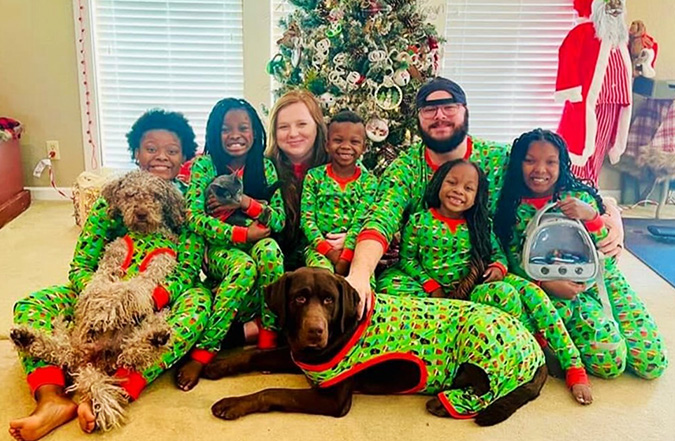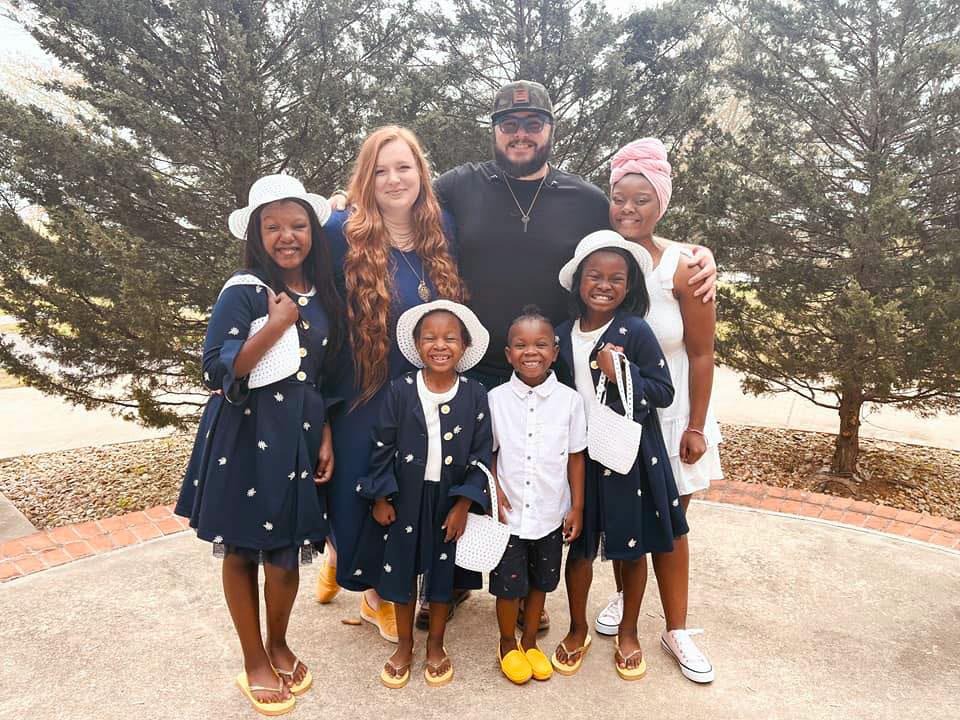
Kayla Moffitt will always remember the moment that she shared her desire to adopt a child from foster care with her husband, Jerad, in the fall of 2018.
“It was a lovely Arkansas day. Jerad was picking up sticks for the last mow of the year when I told him: I want to adopt a waiting child. The look he gave me was one that I will never forget: it was laced with curiosity, excitement… and fear.”
As they learned more about the children in care and the importance of keeping siblings together, Kayla and Jerad set a goal of adopting two children.
“I knew how many siblings were separated in foster care, and I thought that adopting two children wouldn’t rock the boat too much,” Kayla said.
Kayla and Jerad got licensed through a local agency that specializes in sibling adoption and became friends with the director. One afternoon, the director sent them a photo of a brother and four sisters—ages 2 to 13—who needed a family.
“Our immediate response was: They’re super cute, but there are five of them!”
The agency director told Kayla and Jerad that the children had lived apart for most of their lives. Despite all of those years of separation, when she looked at that photo, Kayla could see how deeply attached they were. How could she and Jerad say no?
Less than two years after that fall day in the backyard, Kayla and Jerad were on the verge of becoming parents to five children.
Losing, and then finding, a network of support

The week the children were set to move in, Kayla’s father passed away from COVID. He was 55 years old; his death was completely unexpected. When she and Jerad started their adoption journey, they did so thinking that their parents would be their support system.
“After losing Dad, we felt alone. We didn’t have a huge support system—and the system we had was hurting.”
For help, Kayla turned to online groups and found connections in reading stories of other mothers like her. She studied TBRI (Trust-Based Relational Intervention), an approach that emphasizes “parenting the child, not the behavior.” Kayla learned techniques necessary to disengage from trauma outbursts and regulate stress, including taking “mommy time outs,” splashing cold water on her face, and howling in the backyard with her youngest child when he feels dysregulated.
“I have learned so much about trauma and attachment, and about how much we must extend grace to one another. For one of our daughters, we were her 31st home. That meant we were her 31st set of caretakers, her 31st room, her 31st set of rules and morals and ways to live. How do you encourage a child to trust you and learn to love you when they’ve been told ‘goodbye’ 30 times before?”
Managing the challenge of being a biracial family
Kayla and Jerad were living in a rural town in Arkansas when they decided to adopt. Their children are Black, and Kayla and Jerad are white. Like many parents, they thought their love would be enough to support their children’s racial identity. They quickly realized it was not.
“It’s not that people were racist or mean on purpose—it’s that there is unintentional, learned bias that we watched our kids experience. And at some point, we thought: How long are we going to excuse the ignorance? We need to put our kids first. And that meant making the decision to leave the only home I’d ever known.”
The Moffitts moved to Charlotte, North Carolina, 14 hours away, so that their children could grow up in a diverse community—where they would see doctors and teachers and business owners who looked like them. In that environment, the children flourished.
“The most rewarding experience of my life”

It’s been five years since Kayla and Jerad opened their home and committed to adopting siblings. Years, Kayla says, of challenges, growth, heartbreak, and reward. They’ve watched their children grow from a place of confusion and heartache to stability and identity. And Kayla says that in just a few years, she, Jerad, and the children have gone from being complete strangers to best friends.
When people ask her how they do it or imply that she and Jerad are somehow extraordinary, Kayla is quick to correct them.
“People look at us as more capable, as more special, and that’s not the case. We had an opportunity and we said yes. You don’t have to be special. You just need to be willing.”